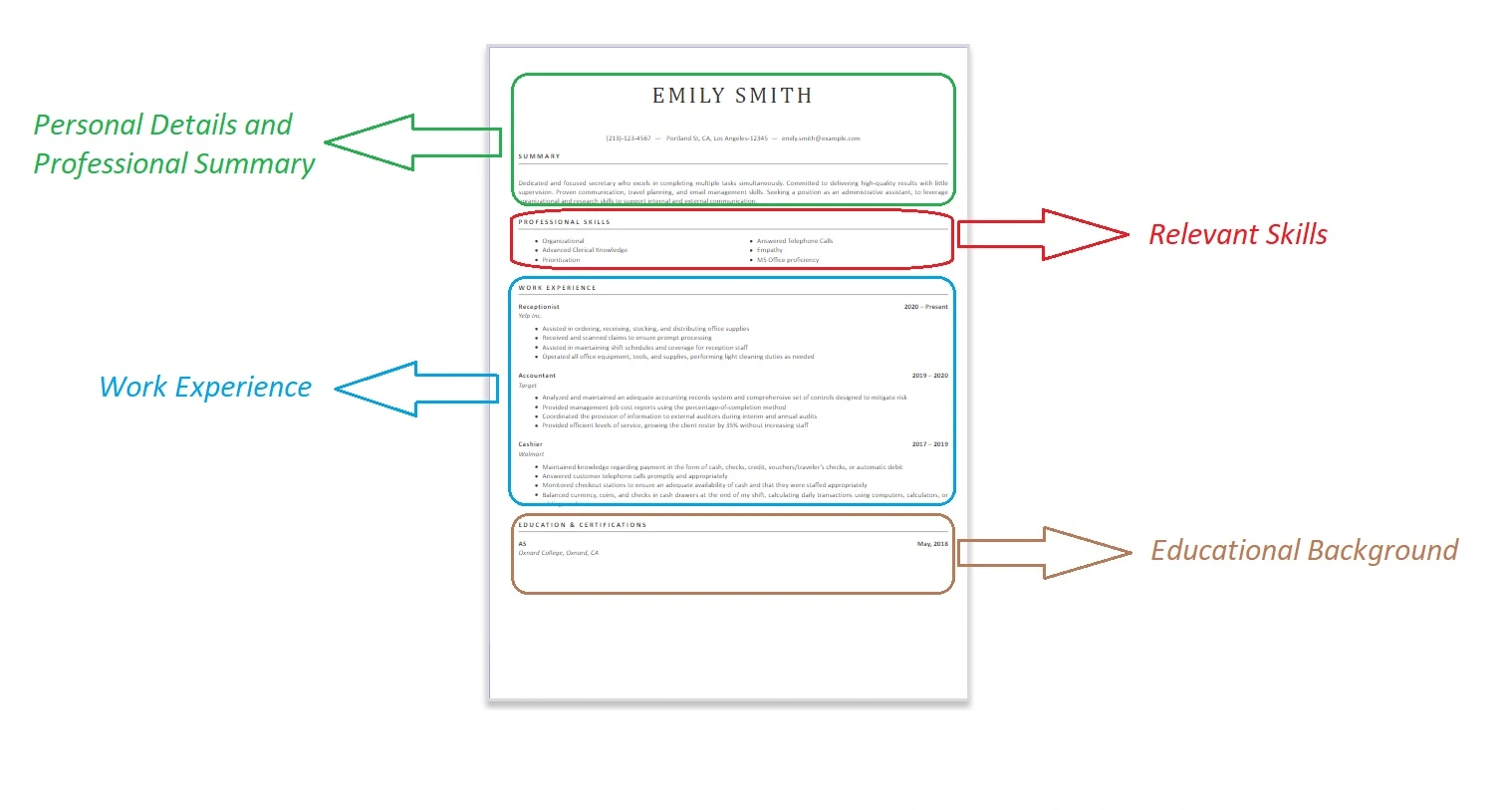Introduction
Whenever you apply for a particular job, you need a good resume to show your qualifications and skills. Resumes are effective ways to demonstrate why you should get hired. A traditional resume is a one-page document that highlights your experience, qualifications, and achievements in a reverse chronological order. Having a good resume in your hands before applying for a job is like having your weapons ready when going to war.
While there are many designs, the classic chronological format is generally right for anyone with continuous experience in the same field. More than 80% of recruiters and hiring managers appreciate this format instead of modern resume formats[1]. This is a standard resume format which is easy to read and scan.
If you are confused about a traditional resume format and want to know more about it, you are at the perfect place.
Traditional Resume and Its Structure
A traditional resume, also known as a classical resume, is a marketing tool that contains your academic background, skill set, milestone achievements, and work experience. A single-page document proves why you are a perfect candidate for this specific position. You can also add some additional information such as contact details, award achievements, memberships, additional programs, and certifications in this format.
The classic resume format does not contain any kind of graphics or creative representation; it uses only texts to represent you in the best form.
Classical resumes format require following a pretty strict structure. A specific order is the most crucial part of this type of format that includes;
- Personal Details and Professional Summary
- Relevant Skills
- Work Experience
- Educational Background

Personal Details and Professional Summary
This section includes the candidate’s personal details such as name, contact information, job description, permanent address, and a short paragraph highlighting your experience, qualifications, and why you fit for this position. The personal details should be written separately from the paragraph in the form of a basic list.
Relevant Skills
All the formats of traditional resumes require including a skills section. You can list around five skills relevant to the company’s requirements. If you include irrelevant skill sets, your resume will more be likely rejected by ATS (Application Tracking System).
Work Experience/Work History
When creating a traditional/classic resumes, it is necessary to include only those work experiences that are compatible with the industry requirements you will apply. You should mention the name of the company you worked for, the job role you had, the start and end date of your employment, and your responsibilities while listing your professional accomplishments.
Educational Background
The education section is the most important part of a classic resumes that you should never miss. This section can outline your educational history, such as studies at higher school, college, university, and other establishments. While mentioning your educational background, you need to include the institute’s name, location, studied years, the subject you studied, and grades.
Build Your Resume with classic resume templates……
Build Your cover letter with our AI powered builder…
Ready to Land Your Next Job?
Don’t let your resume get lost in the stack. Build a professional, ATS-friendly resume that highlights your leadership, achievements, and industry expertise.
Types of Traditional Resume Formats
A traditional resume is a broad term covering three main types of resume formats. These are:-
- Functional Format
- Reverse Chronological Format
- Hybrid Resumes Format
Functional Format
A functional resume format is a commonly used type of classical resume. It mainly focuses on expertise and the relevant skills you have rather than your work experience. If you don’t have much experience, this format allows you to only focus on essential skills to prevent your resume from discouraging. So, this is a good format if you are looking for a career change or just entering the work force without any experience.
Reverse Chronological Format
Job seekers most widely use reverse chronological resume formats. This format emphasizes listing the most relevant professional experience and essential information at the start of the resume. This helps recruiters see your most recent and relevant roles at a glance and increases your chances of growth.
Hybrid Resume Format
Hybrid resume formats contain the specifications of both reverse chronological and functional formats. It allows you to focus on both relevant skill sets and work experience. Most hiring managers appreciate this format of a classic resume.
Still Confused which resume format you should choose?
Read More:- Modern vs Traditional Resume
| Format | Best for | Section order (typical) | Strengths | Watch-outs |
|---|---|---|---|---|
| Traditional (Chronological) | Steady work history Same-field roles measurable results | 1. Header 2. Summary 3. Skills 4. Experience (reverse-chronological) 5. Education 6. Extras | Most familiar to recruiters Clear timeline ATS-friendly with simple formatting | Less ideal with big gaps or very limited experience |
| Functional (Skills-based) | Career changers Students / Limited experience Non-linear paths | 1. Header 2. Summary 3. Skill clusters (with proof) 4. Selected achievements 5. Education / Certifications 6. Experience (brief) | Highlights transferable skills Downplays dates | Some recruiters prefer timelines Still include employers, titles, and dates for ATS |
| Combination (Hybrid) | Mix of skills + solid history; minor gaps/pivots; mid-career | 1. Header 2. Summary 3. Key skills (short) 4. Experience (reverse-chronological) 5. Selected achievements 6. Education 7. Extras | Balances skills and experience Great for growth/leadership | Avoid duplicate bullets 1 page early-career Up to 2 pages experienced |
Advantages of Traditional/Classical Resumes design
The vast majority of hiring corporations will expect you to submit a classic resume because;
- This typical essential resume design uses only one page for early-career to highlight all your specifications. For experience candidates it’s fine to go for 1-2 pages.
- It is common and familiar to hiring managers.
- Uses a variety of formats to accommodate different scenarios.
- It is a great way to cover your work experience, relevant skill sets, educational background, and other important information.
So wait no more, and get in touch with us instantly for top-quality services!
View Professional Resume Templates
Classic Vs Creative Resume
Classic Resume | Creative / Modern Resume |
It accepts long tried, strict, and accepted standards of writing. | It does not need any strict writing standards. |
Works for every field in which you want to apply to. | Works for only specific fields such as graphics and visual arts. |
Use only text representations to highlight your personality. | Uses graphics and art representations to highlight your specifications. |
It does not use modern technology to impress potential recruiters. | Uses technology tools to showcase your skills and qualifications. |
Take a quick look at these samples to learn how the formats compare and which one fits your situation.
Traditional (Chronological)
Sample #1: Financial Analyst (Traditional)
Regina Jackson — City, ST | email@domain.com | (555) 555-5555 | linkedin.com/in/username
Professional Summary
Data-driven Financial Analyst with 4+ years of FP&A experience supporting $50M+ business units. Skilled in forecasting, variance analysis, and dashboards that drive executive decisions.
Experience
Financial Analyst — Acme Manufacturing, San Jose, CA | 2022–Present
- Built driver-based forecast model cutting monthly close time by 30%.
- Automated variance analysis in Excel/Power Query; reduced manual errors 90%.
- Partnered with Ops to identify SKU margin leakage; improved gross margin +2.1 pp.
Junior Financial Analyst — NorthStar Retail, San Jose, CA | 2020–2022
- Consolidated 7 cost centers; produced weekly sales & OPEX reports for VPs.
- Created Tableau dashboards adopted by 3 regions; boosted report usage +40%.
- Supported annual budget cycle ($65M) and quarterly reforecasts.
Education
B.S., Finance — San José State University
Skills
Excel (Power Query, Pivot), SQL, Tableau, Forecasting, Budgeting, Scenario Modeling
Certifications
FMVA (in progress)
Sample #2: Registered Nurse (Traditional)
Regina Jackson — City, ST | email@domain.com | (555) 555-5555 | linkedin.com/in/username
Professional Summary
Compassionate RN with 6 years in acute care (telemetry/med-surg). Proven in patient education, care coordination, and EMR documentation.
Experience
Registered Nurse – Telemetry — Valley Health, Sacramento, CA | 2021–Present
- Managed 4–5:1 patient ratios; achieved 0 medication errors over 18 months.
- Led discharge teaching program; reduced 30-day readmissions –12%.
- Precepted 6 new hires; created quick-reference guides for telemetry alarms.
Registered Nurse – Med-Surg — Mercy General, Sacramento, CA | 2019–2021
- Streamlined bedside shift report; HCAHPS communication scores +9 pts.
- Standardized fall-risk rounding; unit falls –18% year over year.
Education
B.S.N. — CSU Sacramento
Skills
Epic EMR, Cardiac Monitoring, IV/Phlebotomy, Patient Education, Care Coordination
Licenses/Certs
California RN License, BLS, ACLS
Sample #3: Warehouse Team Lead (Traditional)
Regina Jackson — City, ST | email@domain.com | (555) 555-5555 | linkedin.com/in/username
Professional Summary
Warehouse Lead with 7+ years in high-volume fulfillment. Expert in WMS, safety compliance, and lean improvements.
Experience
Warehouse Team Lead — RapidShip 3PL, Fremont, CA | 2021–Present
- Supervise 18 pick/pack associates; order accuracy 99.6%.
- Re-slotted top 200 SKUs; cut average pick path –22%.
- Drove near-miss reporting program; OSHA recordables –35%.
Senior Warehouse Associate — Metro Logistics, Fremont, CA | 2018–2021
- Trained forklift & pallet jack ops; maintained 0 safety violations.
- Introduced cycle counting; inventory variance –60%.
Education
High School Diploma
Skills
WMS (Manhattan), RF Scanners, 5S, Lean Basics, Forklift Cert, Shipping/Receiving
Functional (Skills-Based)
Ready to Land Your Next Job?
Don’t let your resume get lost in the stack. Build a professional, ATS-friendly resume that highlights your leadership, achievements, and industry expertise.
Sample #1: Teacher → Customer Success (Functional)
Regina Jackson — City, ST | email@domain.com | (555) 555-5555 | linkedin.com/in/username
Professional Summary
Former high-school teacher transitioning to Customer Success. Strong in communication, stakeholder education, and problem solving.
Core Skill Clusters & Proof
Customer Education & Onboarding — Created 20+ curricula; improved student completion +18%. Built step-by-step guides and short videos; NPS equivalent +14 pts in pilot.
Relationship Management — Managed 150+ student/parent relationships; resolved conflicts through clear expectations and follow-ups.
Data-Informed Support — Tracked progress in SIS/Sheets; flagged at-risk cohorts, lifting outcomes +12%.
Selected Achievements
- Designed a self-serve “Getting Started” portal (Loom + Docs); cut live Q&A –35%.
- Ran monthly office hours; maintained renewal-like engagement with alumni group.
Work History (Brief)
Teacher, Lincoln High School — 2019–2024
Substitute Teacher, District 12 — 2018–2019
Education
B.A., English — State University
Tools
Google Workspace, Zoom, HubSpot (beginner), Loom, Jira (basic)
Sample #2: Hospitality Manager → Office Administrator (Functional)
Regina Jackson — City, ST | email@domain.com | (555) 555-5555 | linkedin.com/in/username
Professional Summary
Operations-minded hospitality leader pivoting to Office Administration. Known for scheduling, vendor coordination, and documentation.
Core Skill Clusters & Proof
Scheduling & Calendar Control — Managed 30-person rota; reduced coverage gaps –25%.
Vendor & Facilities — Negotiated linen and vending contracts; saved $18K/yr.
Documentation & Compliance — Standardized front-desk SOPs; onboarding time –40%.
Selected Achievements
- Implemented ticketing spreadsheet; average resolution time –28%.
- Organized quarterly exec meetings; on-time starts 98%.
Work History (Brief)
Front-Office Manager, Harbor Suites — 2020–2024
Guest Services Associate, Harbor Suites — 2018–2020
Education
A.A., Business Administration
Tools
MS Office, Google Calendar, Slack, Concur, Asana (basic)
Sample #3: Military Veteran → Project Coordinator (Functional)
Regina Jackson — City, ST | email@domain.com | (555) 555-5555 | linkedin.com/in/username
Professional Summary
U.S. Army veteran transitioning to Project Coordination. Brings logistics, team leadership, and risk awareness.
Core Skill Clusters & Proof
Logistics & Scheduling — Coordinated movement of 120+ personnel/equipment; 0 missed ETAs.
Documentation & Reporting — Produced daily SITREPs; improved decision speed +20%.
Stakeholder Communication — Liaised across units/vendors; resolved blockers within SLA.
Selected Achievements
- Mapped supply process; reduced stockouts –30%.
- Trained 10 peers on new dispatch software; time-to-competency –50%.
Work History (Brief)
Squad Leader / Logistics Specialist — U.S. Army, 2018–2024
Education
Certificate, Project Management Fundamentals — Community College
Tools
Excel, SharePoint, Smartsheet (beginner), Jira (beginner)
Combination (Hybrid)
Sample #1: Software Engineer (Combination)
Regina Jackson — City, ST | email@domain.com | (555) 555-5555 | linkedin.com/in/username
Professional Summary
Full-stack developer (4+ yrs) building performant web apps. Focus on React, Node, and cloud-first APIs.
Key Skills
JavaScript/TypeScript • React • Node.js • REST/GraphQL • Postgres • Docker • CI/CD • Azure
Experience
Software Engineer — Orbit Systems, Remote | 2022–Present
- Shipped React redesign; improved Core Web Vitals (LCP <2.2s) and +19% conversions.
- Built Node/Express microservice; cut report generation from 90s → 8s.
- Added integration tests (Playwright); reduced escaped bugs –35%.
Junior Developer — Lumen Apps, San Jose, CA | 2020–2022
- Implemented features in React/Redux; NPS +10 pts.
- Wrote SQL queries for analytics; created KPI dashboard for PMs.
Education
B.S., Computer Science — CSU East Bay
Projects
Open-source role-based auth library (2k+ npm downloads)
Sample #2: Marketing Manager → Product Marketing (Combination)
Regina Jackson — City, ST | email@domain.com | (555) 555-5555 | linkedin.com/in/username
Professional Summary
Marketing leader pivoting to Product Marketing; strong in positioning, launches, and sales enablement for B2B SaaS.
Key Skills
Positioning/Messaging • Launch GTM • Sales Enablement • Competitive Intel • Content • HubSpot • GA4
Experience
Marketing Manager (Growth) — BrightWave SaaS, San Mateo, CA | 2021–Present
- Led 3 launches; pipeline influenced +$3.2M.
- Built ICP messaging + battlecards; win-rate +6 pp vs. top competitor.
- Produced case-study program (8 stories); sales cycle –12%.
Content Marketer — BrightWave SaaS | 2019–2021
- Drove blog and webinars; MQLs +38% year over year.
Education
B.A., Communications — UC Davis
Certifications
PMM Core (PMM Alliance)
Sample #3: Maintenance Technician (Combination)
Regina Jackson — City, ST | email@domain.com | (555) 555-5555 | linkedin.com/in/username
Professional Summary
Industrial Maintenance Tech with expertise in preventive maintenance, electrical troubleshooting, and safety—ready for Lead Tech responsibilities.
Key Skills
Preventive Maintenance • PLC Basics • Electrical (120/240V) • Hydraulics • CMMS • Root Cause • OSHA
Experience
Maintenance Technician II — Apex Foods, Modesto, CA | 2022–Present
- Implemented PM schedule; unplanned downtime –27%.
- Standardized spare-parts inventory; rush orders –45%.
- Led 5S in maintenance shop; audit scores +15 pts.
Maintenance Technician I — Golden Plastics, Modesto, CA | 2019–2022
- Diagnosed conveyors & packaging lines; MTTR –18%.
- Documented fixes in CMMS; first-pass yield +3.4 pp.
Education
Industrial Maintenance Certificate — Community College
Certifications
OSHA 10, Forklift, HVAC EPA 608 (Type I)
PMM Core (PMM Alliance)
Frequently Asked Questions
Q. How is the traditional/classical resume format different from the modern resume format?
The traditional resume uses traditional ways to impress potential employers, while the modern resume uses modern technologies to highlight your specifications. For example, using a resume format in Word ensures you follow a tried-and-true layout when creating a classic resume.
Q. Does a traditional/classical resume accept different formats?
Yes! Traditional resume covers three major resume formats: functional, reverse-chronological, and hybrid.
Q. How can I create a traditional professional resume?
You can use MyResumeStar’s online smart builders or Microsoft word to create a traditional resume.
Q. When should I use the classical resume format throughout my job search?
The vast majority of hiring managers appreciate this format. You can use the classical resume to find a job in any type of industry except creative industries.
If you are looking for the best traditional/classical resume formats, you must give them a try at MyResumeStar. You can sign up to browse your favourite resume templates. MyResumeStar offers different template styles to provide options for every job seeker.
So wait no more, and create your resume with our professional resume builder…
[1]: Based on a survey done by MyResumeStar.com








